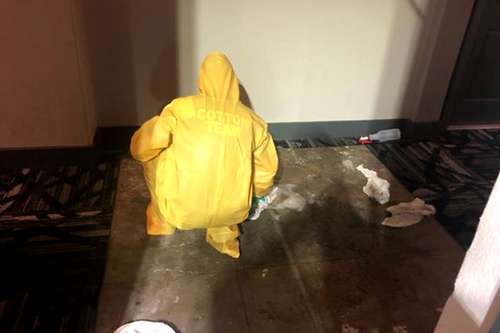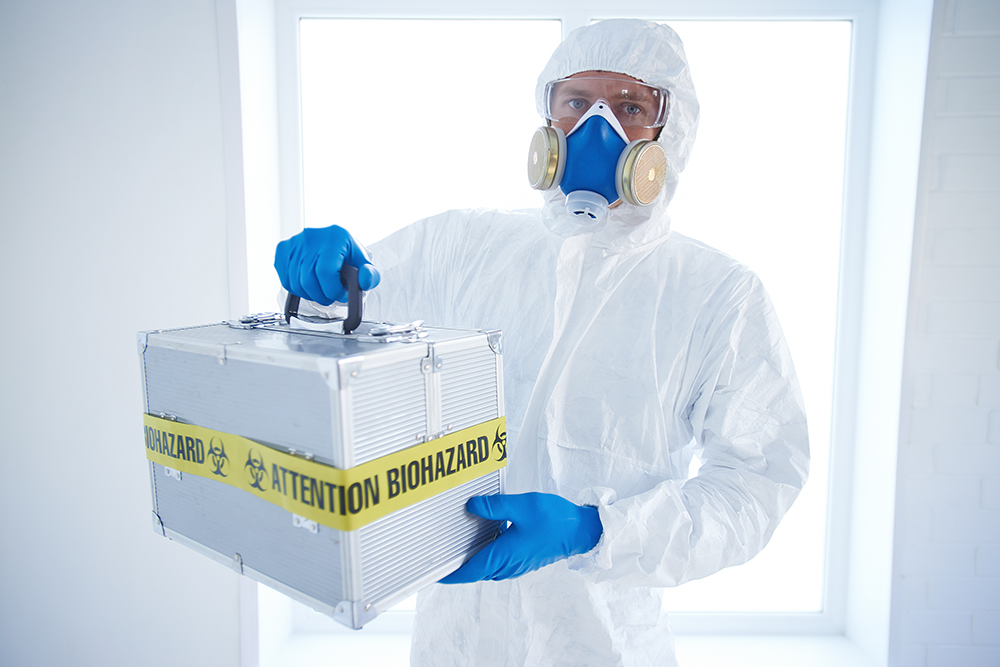Specialist Homicide and Suicide Cleanup: Compassionate and Discreet Providers
Specialist Homicide and Suicide Cleanup: Compassionate and Discreet Providers
Blog Article
Specialist Biohazard Cleaning for Criminal Activity Scenes, Injury Incidents, and Infected Spaces
In the realm of professional biohazard cleanup, precise interest to detail and adherence to security protocols are paramount. When encountered with the after-effects of a criminal offense scene, trauma incident, or any polluted space, the significance of appropriate cleaning can not be downplayed. The risks and intricacies connected with biohazards require specific understanding and knowledge to make certain efficient removal. As we look into the complexities of biohazard cleanup for these delicate environments, a much deeper understanding of the challenges and essential procedures entailed will arise, shedding light on the indispensable function of professional clean-up solutions in bring back safety and tranquility of mind.

Relevance of Biohazard Cleaning
Biohazard cleaning adhering to criminal activity scenes and injury cases is crucial for ensuring the safety and security of people and the setting. When these occurrences happen, they commonly leave a range of biohazards such as blood, bodily liquids, and various other possibly contagious materials. These substances can nurture harmful microorganisms like viruses and bacteria, posturing major health and wellness risks otherwise properly cleaned and disinfected.
Professional biohazard clean-up services are educated to deal with these hazardous products safely and effectively. They have the essential devices, such as personal safety equipment and specialized cleaning representatives, to completely decontaminate the affected locations. By delegating the cleaning to trained specialists, individuals can avoid direct exposure to hazardous virus and stop the spread of infectious conditions.
Additionally, proper biohazard cleaning is important for shielding the atmosphere. Improper disposal of biohazardous materials can infect soil, water resources, and air, presenting a threat to wild animals and the ecosystem. By adhering to stringent cleanup methods, professionals can ensure that biohazards are securely removed and dealt with in accordance with laws, lessening the danger of ecological contamination.
Kinds Of Biohazards Encountered
Various hazardous materials typically experienced in criminal offense scenes and trauma events present considerable health and wellness risks if not dealt with correctly. Blood and bodily fluids are among the most common biohazards found in these situations.
An additional kind of biohazard usually run into is sharp things like needles, damaged glass, and other items that can cause injuries and send infections. Chemical threats are additionally a worry, as criminal offense scenes may contain substances like tear gas, pepper spray, or medicine production materials that require customized handling and disposal treatments to stop additional harm.
Furthermore, mold and mildew and germs growth can occur precede where decay or prolonged exposure to dampness has occurred. These microbes can release toxins and allergens right into the air, presenting respiratory threats to those exposed. Overall, biohazard cleaning professionals have to be trained and fully equipped to efficiently take care of these different kinds of harmful materials to make sure the safety of themselves and others.
Tools and Safety Gear
When attending to the crucial task of dealing with biohazards run into in criminal offense scenes and trauma incidents, the utilization of appropriate equipment and safety gear is extremely important to making sure the safety and security of individuals entailed in the cleaning process. Specialized cleansing devices like biohazard bags, sharps, and anti-bacterials containers are needed for the secure collection and disposal of contaminated products. Making sure that all tools is appropriately maintained, frequently evaluated, and made use of according to safety and security standards is vital in lessening the risk of exposure to biohazards during cleaning operations.
Cleaning Process and Strategies
Effective and detailed cleaning of biohazardous products from crime scenes and trauma occurrences calls for thorough attention to detail and adherence to strict security procedures. The clean-up procedure typically involves several essential steps.
Complying with the removal of biohazardous materials, the afflicted location goes through a detailed cleaning and sanitation procedure. This action entails making use of specialized cleaning representatives and tools to ensure that all traces of contamination are eradicated. After cleaning, the area is subjected to rigorous testing to validate that it is secure and free of any remaining biohazards.

Purification and Disposal Treatments
To make certain complete decontamination and appropriate disposal of biohazardous products, complying with the thorough clean-up process, specific procedures should be meticulously adhered to with stringent adherence to safety methods. Decontamination includes the elimination or neutralization of contaminants to lessen the threat of exposure and spread of harmful materials. This process normally consists of cleansing, decontaminating, and sterilizing the affected location using specialized tools and EPA-approved chemicals.
As soon as decontamination is completed, proper disposal of biohazardous materials is important to stop more contamination or injury. Biohazardous waste, such as physical liquids or blood-soaked materials, need to be meticulously accumulated, packaged, and identified according to regulative guidelines. ATP testing. These materials are then transferred to certified facilities for disposal via suitable networks, making sure compliance with local, state, and federal regulations

Final Thought
In conclusion, expert biohazard cleaning is important for making certain the secure and reliable elimination of harmful materials from criminal offense scenes, trauma events, and polluted rooms. By utilizing specialized tools, protective equipment, and adhering to appropriate clean-up processes and techniques, biohazard clean-up groups can effectively decontaminate and get rid of of biohazards, decreasing the risk of exposure and damage to individuals and the atmosphere.
As we dig into the intricacies of biohazard cleanup for these sensitive atmospheres, a much deeper understanding of the difficulties and essential procedures involved will emerge, dropping light on the crucial duty of specialist cleaning solutions in bring back safety and security and tranquility of mind.
Specialist biohazard cleaning solutions are educated to take care of these hazardous products securely and successfully. By adhering to stringent clean-up procedures, experts can make sure that biohazards are safely eliminated and disposed of in accordance with regulations, minimizing the danger of ecological contamination.
On the whole, biohazard cleaning experts need to be qualified and well-equipped to effectively take care of these numerous types of hazardous products to make certain the security of themselves and others.
When attending to the vital task of handling biohazards ATP testing run into in criminal activity scenes and trauma incidents, the use of proper devices and protective gear is paramount to ensuring the safety and security of people involved in the cleaning process.
Report this page